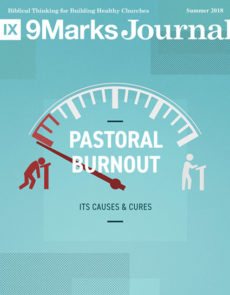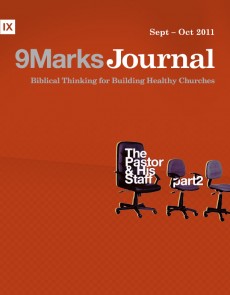PORTRAIT PAINTING DEMO || Oil Painting Time-Lapse
Life Together
Discipling a Generation Who Grew Up with Porn
I was blessed to grow up in a
time when pornography was still pretty tough to find. Magazines sat in
sealed plastic bags behind sales counters, and you had to pay for any
channels or movies that had pornographic content. Don’t get me wrong—I
saw pornography as a teenager, but I didn’t see very much of it.
Sadly, that’s not the case with the young men and women in our churches today. Most of them are “digital natives.” They don’t remember a time without iPhones, iPads, and free WiFi everywhere. And many of them don’t remember a time without unlimited access to pornography.
 I’m a pastor in a college town, not a social scientist. I can’t tell
you how many young Christians view pornography regularly. But I can tell
you that when I meet with young men, I don’t have to ask, “Have you
struggled with pornography?” I can save time by simply asking, “Would
you tell me about your struggle with pornography?”
I’m a pastor in a college town, not a social scientist. I can’t tell
you how many young Christians view pornography regularly. But I can tell
you that when I meet with young men, I don’t have to ask, “Have you
struggled with pornography?” I can save time by simply asking, “Would
you tell me about your struggle with pornography?”
Church, we have a serious problem on our hands, and it’s only getting worse. Every week, young people are coming into our churches, weighed down with guilt and shame. Many express a genuine desire to be free from their sin, but they don’t know what to do. And often, church leaders don’t know how to help them.
So how should we respond to the pornography crisis in our churches, particularly among young people who can’t remember life without it?
First, we must teach young Christians to be sober-minded about their slavery to sin.
Dozens of young men over the years have confessed to me, “I’m struggling with lust.” When I ask them to tell me more about the extent of their struggle, they tell me that they’re viewing pornography weekly, multiple times per week, or even daily.
If someone is using illegal drugs like this, we don’t refer to that as a “struggle.” We call it what it is—an addiction.
But for some reason, when it comes to Christians viewing pornography we don’t use the language of addiction, or what the Scriptures would call “slavery to sin” (Rom. 6:6, Gal. 4:3). No, we soften the blunt edge of reality with the language of “struggle.”
As long as we allow young Christians to believe they’re “struggling” with pornography when they’re enslaved to it, they won’t be willing to take the drastic steps necessary to walk in repentance. The addict will never go to rehab until she’s convinced that she’s an addict.
Second, we must train young Christians to flee from temptation.
One of the best ways to get out of a compromising situation is to never put yourself in a compromising situation to begin with. But many young Christians do, especially with respect to the entertainment they consume.
Wildly popular shows like Game of Thrones and Westworld feature graphic sex, and yet many young Christians watch these shows without a second thought. In his article “12 Questions to Ask Before You Watch Game of Thrones,” John Piper writes:
Nudity is not like murder and violence on the screen. Violence on a screen is make-believe; nobody really gets killed. But nudity is not make-believe. These actresses are really naked in front of the camera, doing exactly what the director says to do with their legs and their hands and their breasts.
The Apostle Paul wrote, “Flee from sexual immorality. Every other sin a person commits is outside the body, but the sexually immoral person sins against his own body” (1 Cor. 6:18).
Fleeing sexuality immorality includes avoiding entertainment that may be sinful in itself, but also might be a “gateway” to pornography usage.
Third, we must train young Christians to fight.
John Owen wrote, “Be killing sin or it will be killing you.” We’re in a fight to the death with sin. But the way many young Christians deal with sin is like watching a movie fight. There’s lots of tough talk, dancing around, and blocking.
If you take a self-defense class, your instructor will first of all tell you to avoid a fight at all costs. But if a fight is unavoidable, then the person who goes in first, fast, and furious is usually going to win. No talking. No dancing around. No blocking.
Jesus said, “If your right eye causes you to sin, tear it out and throw it away. For it is better that you lose one of your members than that your whole body be thrown into hell” (Matt. 5:29)
We’ve got to train young Christians to fight like this. Many will find victory through the ordinary means of grace—reading Scripture, prayer, and accountability in the church. Others will need to “cut out the eye,” which could include exchanging their smartphone for a “dumbphone” with no internet access, or deciding only to use computers in public libraries rather than buying a laptop.
Digital natives have a hard time believing that people survived without smartphones and laptops, but as Jesus says, it’s better to lose something temporary than something eternal. The key is to take whatever measures are necessary to fight against besetting sins. That’s the only way to win a fight to the death.
Finally, we must point young Christians to the gospel of Jesus Christ.
Many young men and women have been battling pornography addiction for years. They’re ashamed and discouraged. And while we need to train them to flee and to fight, the best thing we can do is point them to the gospel.
Jesus was tempted in every way—including to lust after women—and yet he never sinned. We must remember that his perfectly obedient life, his sin-atoning death, and his death-defeating resurrection isn’t only the key to our forgiveness, but to our sanctification and joy.
If Jesus is powerful enough to raise the dead to life through the regenerating work of the Holy Spirit, then he is powerful enough to deliver us from our besetting sins. And that includes addiction to pornography.
Sadly, that’s not the case with the young men and women in our churches today. Most of them are “digital natives.” They don’t remember a time without iPhones, iPads, and free WiFi everywhere. And many of them don’t remember a time without unlimited access to pornography.
 I’m a pastor in a college town, not a social scientist. I can’t tell
you how many young Christians view pornography regularly. But I can tell
you that when I meet with young men, I don’t have to ask, “Have you
struggled with pornography?” I can save time by simply asking, “Would
you tell me about your struggle with pornography?”
I’m a pastor in a college town, not a social scientist. I can’t tell
you how many young Christians view pornography regularly. But I can tell
you that when I meet with young men, I don’t have to ask, “Have you
struggled with pornography?” I can save time by simply asking, “Would
you tell me about your struggle with pornography?”Church, we have a serious problem on our hands, and it’s only getting worse. Every week, young people are coming into our churches, weighed down with guilt and shame. Many express a genuine desire to be free from their sin, but they don’t know what to do. And often, church leaders don’t know how to help them.
So how should we respond to the pornography crisis in our churches, particularly among young people who can’t remember life without it?
First, we must teach young Christians to be sober-minded about their slavery to sin.
Dozens of young men over the years have confessed to me, “I’m struggling with lust.” When I ask them to tell me more about the extent of their struggle, they tell me that they’re viewing pornography weekly, multiple times per week, or even daily.
If someone is using illegal drugs like this, we don’t refer to that as a “struggle.” We call it what it is—an addiction.
But for some reason, when it comes to Christians viewing pornography we don’t use the language of addiction, or what the Scriptures would call “slavery to sin” (Rom. 6:6, Gal. 4:3). No, we soften the blunt edge of reality with the language of “struggle.”
As long as we allow young Christians to believe they’re “struggling” with pornography when they’re enslaved to it, they won’t be willing to take the drastic steps necessary to walk in repentance. The addict will never go to rehab until she’s convinced that she’s an addict.
Second, we must train young Christians to flee from temptation.
One of the best ways to get out of a compromising situation is to never put yourself in a compromising situation to begin with. But many young Christians do, especially with respect to the entertainment they consume.
Wildly popular shows like Game of Thrones and Westworld feature graphic sex, and yet many young Christians watch these shows without a second thought. In his article “12 Questions to Ask Before You Watch Game of Thrones,” John Piper writes:
Nudity is not like murder and violence on the screen. Violence on a screen is make-believe; nobody really gets killed. But nudity is not make-believe. These actresses are really naked in front of the camera, doing exactly what the director says to do with their legs and their hands and their breasts.
The Apostle Paul wrote, “Flee from sexual immorality. Every other sin a person commits is outside the body, but the sexually immoral person sins against his own body” (1 Cor. 6:18).
Fleeing sexuality immorality includes avoiding entertainment that may be sinful in itself, but also might be a “gateway” to pornography usage.
Third, we must train young Christians to fight.
John Owen wrote, “Be killing sin or it will be killing you.” We’re in a fight to the death with sin. But the way many young Christians deal with sin is like watching a movie fight. There’s lots of tough talk, dancing around, and blocking.
If you take a self-defense class, your instructor will first of all tell you to avoid a fight at all costs. But if a fight is unavoidable, then the person who goes in first, fast, and furious is usually going to win. No talking. No dancing around. No blocking.
Jesus said, “If your right eye causes you to sin, tear it out and throw it away. For it is better that you lose one of your members than that your whole body be thrown into hell” (Matt. 5:29)
We’ve got to train young Christians to fight like this. Many will find victory through the ordinary means of grace—reading Scripture, prayer, and accountability in the church. Others will need to “cut out the eye,” which could include exchanging their smartphone for a “dumbphone” with no internet access, or deciding only to use computers in public libraries rather than buying a laptop.
Digital natives have a hard time believing that people survived without smartphones and laptops, but as Jesus says, it’s better to lose something temporary than something eternal. The key is to take whatever measures are necessary to fight against besetting sins. That’s the only way to win a fight to the death.
Finally, we must point young Christians to the gospel of Jesus Christ.
Many young men and women have been battling pornography addiction for years. They’re ashamed and discouraged. And while we need to train them to flee and to fight, the best thing we can do is point them to the gospel.
Jesus was tempted in every way—including to lust after women—and yet he never sinned. We must remember that his perfectly obedient life, his sin-atoning death, and his death-defeating resurrection isn’t only the key to our forgiveness, but to our sanctification and joy.
If Jesus is powerful enough to raise the dead to life through the regenerating work of the Holy Spirit, then he is powerful enough to deliver us from our besetting sins. And that includes addiction to pornography.
Coping means to invest one's own conscious effort, to solve personal and interpersonal problems, in order to try to master, minimize or tolerate stress and conflict.[1][2][3][4][5]
The psychological coping mechanisms are commonly termed coping strategies or coping skills. The term coping generally refers to adaptive (constructive) coping strategies. That is strategies which reduce stress. In contrast, other coping strategies may be coined as maladaptive, if they increase stress. Maladaptive coping is therefore also described, when looking at the outcome, as non-coping. Furthermore, the term coping generally refers to reactive coping, i.e. the coping response which follows the stressor. This differs from proactive coping, in which a coping response aims to neutralize a future stressor. Subconscious or non-conscious strategies (e.g. defense mechanisms) are generally excluded from the area of coping.
The effectiveness of the coping effort depends on the type of stress, the individual, and the circumstances. Coping responses are partly controlled by personality (habitual traits), but also partly by the social environment, particularly the nature of the stressful environment.[6]
Types of coping strategies
Hundreds of coping strategies have been identified.[6] Classification of these strategies into a broader architecture has not been agreed upon. Researchers try to group coping responses rationally, empirically by factor analysis, or through a blend of both techniques.[7]:751 In the early days, Folkman and Lazarus split the coping strategies into four groups, namely problem-focused, emotion-focused, support-seeking, and meaning-making coping.[7][8]:303 Other research, like Weiten, for instance, identifies four types of coping strategies:,[1] like Appraisal-focused (adaptive cognitive), Problem-focused (adaptive behavioral), Emotion-focused, Occupation-focused coping. Billings and Moos added avoidance coping as one of the emotion-focused coping.[9] Some scholar questioned the psychometric validity of forced categorisation as those strategies are not independent to each other.[7]:753 Besides, in reality, people can adopt multiple coping strategies simultaneously.Appraisal-focused strategies occur when the person modifies the way they think, for example: employing denial, or distancing oneself from the problem. People may alter the way they think about a problem by altering their goals and values, such as by seeing the humor in a situation: "some have suggested that humor may play a greater role as a stress moderator among women than men".[10]
People using problem-focused strategies try to deal with the cause of their problem. They do this by finding out information on the problem and learning new skills to manage the problem. Problem-focused coping is aimed at changing or eliminating the source of the stress. The three problem-focused coping strategies identified by Folkman and Lazarus are: taking control, information seeking, and evaluating the pros and cons. However, problem-focused coping may not necessarily adaptive, but backfire, especially in the uncontrollable case that one cannot make the problem away.[8]:303
Emotion-focused strategies involve:
- releasing pent-up emotions
- distracting oneself[7]:751
- managing hostile feelings
- meditating
- using systematic relaxation procedures.
- disclaiming
- escape-avoidance
- accepting responsibility or blame
- exercising self-control
- and positive reappraisal.
- seeking social support
- reappraising the stressor in a positive light
- accepting responsibility
- using avoidance
- exercising self-control
- and distancing.[13][14]
Typically, people use a mixture of several types of coping strategies, which may change over time. All these strategies can prove useful, but some claim that those using problem-focused coping strategies will adjust better to life.[18] Problem-focused coping mechanisms may allow an individual greater perceived control over their problem, whereas emotion-focused coping may sometimes lead to a reduction in perceived control (maladaptive coping).
Lazarus "notes the connection between his idea of 'defensive reappraisals' or cognitive coping and Freud's concept of 'ego-defenses'",[12] coping strategies thus overlapping with a person's defense mechanisms.
Future oriented proactive coping
One coping method, anticipating a problem, is known as proactive coping.[11] Anticipation is when one reduces the stress of some difficult challenge by anticipating what it will be like and preparing for how one is going to cope with it.[19]Social coping
Two others are social coping, such as seeking social support from others, meaning-focused coping, in which the person concentrates on deriving meaning from the stressful experience.[11]Adequate nutrition, exercise, sleep contribute to stress management, as do physical fitness and relaxation techniques such as progressive muscle relaxation.[20]
Humor
Humor used as a positive coping method may have useful benefits to emotional and mental health well-being. By having a humorous outlook on life, stressful experiences can be and are often minimized. This coping method corresponds with positive emotional states and is known to be an indicator of mental health.[21] Physiological processes are also influenced within the exercise of humor. For example, laughing may reduce muscle tension, increase the flow of oxygen to the blood, exercise the cardiovascular region, and produce endorphins in the body.[22] Using humor in coping while processing through feelings can vary depending on life circumstance and individual humor styles. In regards to grief and loss in life occurrences, it has been found that genuine laughs/smiles when speaking about the loss predicted later adjustment and evoked more positive responses from other people.[23] A person of the deceased family member may resort to making jokes of when the deceased person used to give unwanted “wet willies” (term used for when a person sticks their finger inside their mouth then inserts the finger into another person's ear) to any unwilling participant. A person might also find comedic relief with others around irrational possible outcomes for the deceased funeral service. It is also possible that humor would be used by people to feel a sense of control over a more powerless situation and used as way to temporarily escape a feeling of helplessness. Exercised humor can be a sign of positive adjustment as well as drawing support and interaction from others around the loss.[24]Negative techniques (maladaptive coping or non-coping)
While adaptive coping strategies improve functioning, a maladaptive coping technique will just reduce symptoms while maintaining and strengthening the disorder. Maladaptive techniques are more effective in the short term rather than long term coping process.Examples of maladaptive behavior strategies include dissociation, sensitization, safety behaviors, anxious avoidance, and escape (including self-medication).
These coping strategies interfere with the person's ability to unlearn, or break apart, the paired association between the situation and the associated anxiety symptoms. These are maladaptive strategies as they serve to maintain the disorder.
Dissociation is the ability of the mind to separate and compartmentalize thoughts, memories, and emotions. This is often associated with post traumatic stress syndrome.
Sensitization is when a person seeks to learn about, rehearse, and/or anticipate fearful events in a protective effort to prevent these events from occurring in the first place.
Safety behaviors are demonstrated when individuals with anxiety disorders come to rely on something, or someone, as a means of coping with their excessive anxiety.
Anxious avoidance is when a person avoids anxiety provoking situations by all means. This is the most common method.
Escape is closely related to avoidance. This technique is often demonstrated by people who experience panic attacks or have phobias. These people want to flee the situation at the first sign of anxiety.[25]
Further examples
Further examples of coping strategies include[26] emotional or instrumental support, self-distraction, denial, substance use, self-blame, behavioral disengagement and the use of drugs or alcohol.[27]Many people think that meditation "not only calms our emotions, but...makes us feel more 'together'", as too can "the kind of prayer in which you're trying to achieve an inner quietness and peace".[28]
Low-effort syndrome or low-effort coping refers to the coping responses of minority groups in an attempt to fit into the dominant culture. For example, minority students at school may learn to put in only minimal effort as they believe they are being discriminated against by the dominant culture.[29]
Historical psychoanalytic theories
Otto Fenichel
Otto Fenichel summarized early psychoanalytic studies of coping mechanisms in children as "a gradual substitution of actions for mere discharge reactions...[&] the development of the function of judgement" - noting however that "behind all active types of mastery of external and internal tasks, a readiness remains to fall back on passive-receptive types of mastery."[30]In adult cases of "acute and more or less 'traumatic' upsetting events in the life of normal persons", Fenichel stressed that in coping, "in carrying out a 'work of learning' or 'work of adjustment', [s]he must acknowledge the new and less comfortable reality and fight tendencies towards regression, towards the misinterpretation of reality", though such rational strategies "may be mixed with relative allowances for rest and for small regressions and compensatory wish fulfillment, which are recuperative in effect".[31]
Karen Horney
In the 1940s, the German Freudian psychoanalyst Karen Horney "developed her mature theory in which individuals cope with the anxiety produced by feeling unsafe, unloved, and undervalued by disowning their spontaneous feelings and developing elaborate strategies of defence."[32] She defined four so-called coping strategies to define interpersonal relations, one describing psychologically healthy individuals, the others describing neurotic states.The healthy strategy she termed "Moving with" is that with which psychologically healthy people develop relationships. It involves compromise. In order to move with, there must be communication, agreement, disagreement, compromise, and decisions. The three other strategies she described – "Moving toward", "Moving against" and "Moving away" – represented neurotic, unhealthy strategies people utilize in order to protect themselves.
Horney investigated these patterns of neurotic needs (compulsive attachments).[33] The neurotics might feel these attachments more strongly because of difficulties within their lives. If the neurotic does not experience these needs, he or she will experience anxiety. The ten needs are:[34]
- Affection and approval, the need to please others and be liked
- A partner who will take over one's life, based on the idea that love will solve all of one's problems
- Restriction of one's life to narrow borders, to be undemanding, satisfied with little, inconspicuous; to simplify one's life
- Power, for control over others, for a facade of omnipotence, caused by a desperate desire for strength and dominance
- Exploitation of others; to get the better of them
- Social recognition or prestige, caused by an abnormal concern for appearances and popularity
- Personal admiration
- Personal achievement.
- Self-sufficiency and independence
- Perfection and unassailability, a desire to be perfect and a fear of being flawed.
In Withdrawal, also known as "Moving away" or the "Resigning solution", individuals distance themselves from anyone perceived as a threat to avoid getting hurt – "the 'mouse-hole' attitude ... the security of unobtrusiveness."[37] The argument is, "If I do not let anyone close to me, I won't get hurt." A neurotic, according to Horney desires to be distant because of being abused. If they can be the extreme introvert, no one will ever develop a relationship with them. If there is no one around, nobody can hurt them. These "moving away" people fight personality, so they often come across as cold or shallow. This is their strategy. They emotionally remove themselves from society. Included in this strategy are neurotic needs three, nine, and ten.[36]
In Aggression, also known as the "Moving against" or the "Expansive solution", the individual threatens those perceived as a threat to avoid getting hurt. Children might react to parental in-differences by displaying anger or hostility. This strategy includes neurotic needs four, five, six, seven, and eight.[38]
Related to the work of Karen Horney, public administration scholars[39] developed a classification of coping by frontline workers when working with clients (see also the work of Michael Lipsky on street-level bureaucracy). This coping classification is focused on the behavior workers can display towards clients when confronted with stress. They show that during public service delivery there are three main families of coping:
- Moving towards clients: Coping by helping clients in stressful situations. An example is a teacher working overtime to help students.
- Moving away from clients: Coping by avoiding meaningful interactions with clients in stressful situations. An example is a public servant stating "the office is very busy today, please return tomorrow."
- Moving against clients: Coping by confronting clients. For instance, teachers can cope with stress when working with students by imposing very rigid rules, such as no cellphone use in class and sending everyone to the office when they use a cellphone. Furthermore, aggression towards clients is also included here.
In their systematic review of 35 years of the literature, the scholars found that the most often used family is moving towards clients (43% of all coping fragments). Moving away from clients was found in 38% of all coping fragments and Moving against clients in 19%.
Heinz Hartmann
In 1937, the psychoanalyst (as well as a physician, psychologist, and psychiatrist) Heinz Hartmann marked it as the evolution of ego psychology by publishing his paper, "Me" (which was later translated into English in 1958, titled, "The Ego and the Problem of Adaptation").[40] Hartmann focused on the adaptive progression of the ego "through the mastery of new demands and tasks".[41] In fact, according to his adaptive point of view, once infants were born they have the ability to be able to cope with the demands of their surroundings.[40] In his wake, ego psychology further stressed "the development of the personality and of 'ego-strengths'...adaptation to social realities".[42]Object relations
Emotional intelligence has stressed the importance of "the capacity to soothe oneself, to shake off rampant anxiety, gloom, or irritability....People who are poor in this ability are constantly battling feelings of distress, while those who excel in it can bounce back far more quickly from life's setbacks and upsets".[43] From this perspective, "the art of soothing ourselves is a fundamental life skill; some psychoanalytic thinkers, such as John Bowlby and D. W. Winnicott see this as the most essential of all psychic tools."[44]Object relations theory has examined the childhood development both of "[i]ndependent coping...capacity for self-soothing", and of "[a]ided coping. Emotion-focused coping in infancy is often accomplished through the assistance of an adult."[45]
Gender differences
Gender differences in coping strategies are the ways in which men and women differ in managing psychological stress. There is evidence that males often develop stress due to their careers, whereas females often encounter stress due to issues in interpersonal relationships.[46] Early studies indicated that "there were gender differences in the sources of stressors, but gender differences in coping were relatively small after controlling for the source of stressors";[47] and more recent work has similarly revealed "small differences between women's and men's coping strategies when studying individuals in similar situations."[48]In general, such differences as exist indicate that women tend to employ emotion-focused coping and the "tend-and-befriend" response to stress, whereas men tend to use problem-focused coping and the "fight-or-flight" response, perhaps because societal standards encourage men to be more individualistic, while women are often expected to be interpersonal. An alternative explanation for the aforementioned differences involves genetic factors. The degree to which genetic factors and social conditioning influence behavior, is the subject of ongoing debate.[49]
Physiological basis
Hormones also play a part in stress management. Cortisol, a stress hormone, was found to be elevated in males during stressful situations. In females, however, cortisol levels were decreased in stressful situations, and instead, an increase in limbic activity was discovered. Many researchers believe that these results underlie the reasons why men administer a fight-or-flight reaction to stress; whereas, females have a tend-and-befriend reaction.[50] The "fight-or-flight" response activates the sympathetic nervous system in the form of increased focus levels, adrenaline, and epinephrine. Conversely, the "tend-and-befriend" reaction refers to the tendency of women to protect their offspring and relatives. Although these two reactions support a genetic basis to differences in behavior, one should not assume that in general females cannot implement "fight-or-flight" behavior or that males cannot implement "tend-and-befriend" behavior.See also
- Dyscopia
- Defence mechanisms (Level 4: Mature)
- Emotional intelligence
- Experiential avoidance
- Grief
- Invisible support
- Life skills
- Mindfulness-based stress reduction
- Music as a coping strategy
- Psychological resilience
- Psychological trauma
- Self-compassion
- Self-control
- Social sharing of emotions
- Stiff upper lip
- Stress
- Stress management
- Self-concealment
- Stigma management
- Adaptive performance
References
- Wang, J.; Korczykowski, M.; Rao, H.; Fan, Y.; Pluta, J.; Gur, R. C.; McEwen, B. S.; Detre, J. A. (2007). "Gender difference in neural response to psychological stress". Social Cognitive and Affective Neuroscience. 2 (3): 227–39. doi:10.1093/scan/nsm018. PMC 1974871. PMID 17873968.
Further reading
- Susan Folkman and Richard S. Lazarus, "Coping and Emotion", in Nancy Stein et al. eds., Psychological and Biological Approaches to Emotion (1990)
- Brougham, Ruby R.; Zail, Christy M.; Mendoza, Celeste M.; Miller, Janine R. (2009). "Stress, Sex Differences, and Coping Strategies Among College Students". Current Psychology. 28 (2): 85–97. doi:10.1007/s12144-009-9047-0.
External links
Languages
Create the page "Coping" on this wiki! See also the search results found.
-
Transactional model of stress and coping. What is the transactional model and what can we learn from it? In 1966, Dr Richard Lazarus first wrote about27 KB (3,688 words) - 03:53, 7 February 2019
-
Learn how you can help Wikiversity to develop it. Psychological coping (or coping strategies) refers to the behavioural and cognitive efforts made by1 KB (159 words) - 03:12, 3 April 2018
-
Coping with stigma: What characterises adaptive versus maladaptive coping with stigma? Stigmatisation occurs in all societies and can cause much difficulty17 KB (2,661 words) - 05:58, 29 November 2016
-
Fear and coping: How do people cope with fear? Fear is a common emotion which many people face in their day to day lives. Whether this fear is an irrational25 KB (3,544 words) - 03:23, 8 May 2016
-
Archer, J., Cantwell, R., & Bourke, S. (1999). Coping at university: An examination of achievement, motivation, self-regulation, confidence, and method4 KB (509 words) - 22:22, 8 April 2018
-
stimuli. Coping is “anyway that we may voluntarily try to control stress or anxiety in ourselves” (Beck R.C. 2004) through problem focused coping or emotion12 KB (1,810 words) - 17:20, 27 June 2019
-
cdc.gov/coping/selfcare.asp https://www.cdc.gov/masstrauma/factsheets/professionals/coping_professional.pdf https://emergency.cdc.gov/coping/selfcare21 KB (1,968 words) - 23:40, 14 May 2019
-
Menec, V. (2000). An examination of the relationship among academic stress, coping, motivation, and performance in college. Research in Higher Education, 41(5)24 KB (910 words) - 22:32, 8 April 2018
-
transactional model of stress and coping. This model focusses on the role of cognitive-emotional appraisal and coping behaviour, and how it relates to35 KB (3,370 words) - 23:16, 18 June 2019
-
Recently edited Motivation and emotion/Textbook/Emotion/Stress, arousal and coping Motivation and emotion/Textbook/Motivation/Arousal Motivation and emotion/Book/Unselected11 KB (530 words) - 19:11, 2 June 2018
- Motivation and emotion/Book/2014/Religiosity and mental health (section Religion as a coping mechanism)religious coping mechanisms psychological underpinnings, its classification is vague. Religious coping is linked to both problem and emotion-focused coping; however31 KB (3,993 words) - 10:50, 17 September 2016
-
Emotional eating: How and why do people use eating as a coping strategy to deal with negative emotions? Do you find yourself reaching for the chocolate28 KB (2,263 words) - 22:53, 31 May 2018
-
permission of the author. See: http://emotionalcompetency.blogspot.com/2009/10/coping-with-abundance.html Stone Zander, Rosamund; Zander, Benjamin (2002). The6 KB (905 words) - 20:21, 12 November 2016
-
and cope with egos—yours and others. Students wishing to learn more about coping with ego may be interested in reading the following books: Hofstadter, Douglas42 KB (6,014 words) - 02:54, 10 May 2019
-
types of coping mechanisms in the DPM of coping and are loss orientation and restoration orientation coping mechanisms. Loss orientation coping involves29 KB (2,900 words) - 22:59, 17 November 2018
-
appraisal and coping appraisal (Sturges & Rogers, 1996). Essentially PMT show the difference and distinguishes between adaptive and maladaptive coping behaviours31 KB (3,110 words) - 15:37, 31 May 2018
- Motivation and emotion/Book/2015/Alcohol addiction and emotion (section Coping with negative emotions)traditionally two categories for coping, one being problem focused, and two being emotion focused. Problem focused coping strategies are related to activities31 KB (3,963 words) - 01:42, 31 December 2018
-
Psychological stress and coping process. New York, US: McGraw-Hill. Lazarus, R. S. (1999). Hope: An emotion and a vital coping resource against despair34 KB (1,285 words) - 05:08, 25 November 2018
- Motivation and emotion/Book/2013/Religiousity and emotion (section Religiosity and coping strategies)(Pargament, Koenig, & and Perez, 2000). Two coping methods were discovered negative and positive; Negative coping consists of spiritual struggle, and positive24 KB (3,565 words) - 10:48, 17 September 2016
-
perceived coping ability (-.39). The significant positive relationship was found between the participants' perceived English ability and their coping ability11 KB (1,429 words) - 13:33, 25 February 2018

























































































































Comments